Dedicated to a new age of restoration
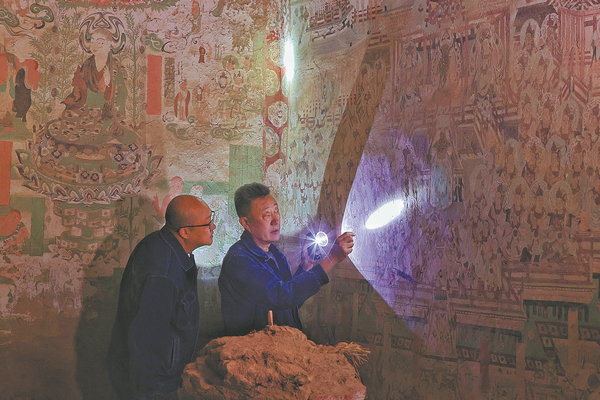
Li Bo (right), a veteran restorer of the Dunhuang Academy, leads a colleague, Li Lingzhi, in examining murals in one of the Yulin Caves at Guazhou county near Dunhuang, Gansu province. JIANG DONG/CHINA DAILY
The spirit of continuity, which spans the generations who protect the caves, remains evident, report Fang Aiqing, Wang Kaihao in Dunhuang, Gansu province, and Ma Jingna in Lanzhou.
It's a race against time, as generations of cultural heritage conservators at the Dunhuang Academy endeavor to protect the artistic charm of the Mogao Caves, a UNESCO World Heritage Site, despite erosion by sand and wind.
Restorer Li Bo is a member of the team that is dedicated to protecting the 45,000 square meters of murals and more than 2,400 painted sculptures of the 735 caves of the site, the construction of which spans a millennium, from the 4th century to the 14th century.
Located in the far west of Northwest China's Gansu province, the city of Dunhuang and its neighboring areas — home to the Mogao Caves and other historical monuments witnessing the apex of the ancient, prosperous Silk Road — just unrolled a saga testifying to communication among civilizations across Eurasia.
While characters on the ancient murals refer to Buddha for the truth of life and the universe — a frequent theme of the murals — Li's pilgrimage to enlightenment is reflected in every moment of him sitting in front of the wall and reviving the revelations in the murals with meticulous hand movements, bit by bit, from dawn to dusk, day after day.
A sophisticated mural restorer like Li, who has spent more than 30 years in the business, can only restore an area about the size of a sheet of paper each day.
The past three decades have seen him repair around 1,500 square meters of murals and more than 300 sculptures — the small ones are only about 20 centimeters tall, while the largest reach more than 20 meters in height.
The years have also brought him the exclusive joy of holding a silent dialogue with the mural characters every working day.
In front of a 10th-century mural featuring a mass audience listening to the Buddha at the Yulin Caves in Guazhou county, around two hours' drive from the Mogao Caves, Li mimicked the facial expressions of the characters when introducing his routine work.
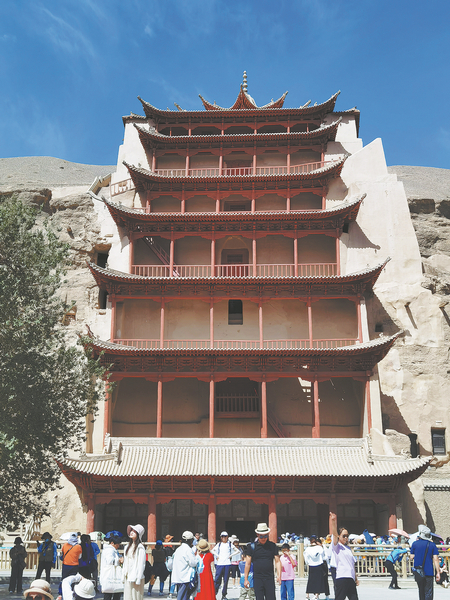
The Mogao Caves in Dunhuang are a popular destination for tourists. WANG KAIHAO/CHINA DAILY
The site, which, archaeologists estimate, dates back to the Northern Wei Dynasty (386-534), shares cultural and artistic consistency with the Mogao Caves. The Dunhuang Academy also oversees the Yulin Caves.
As the mural vividly portrays, some listeners slightly lean forward, thirsty for knowledge. Some are puzzled, some look around. Some whisper to others, while some doze off.
It was Li's most relaxed moment during the interview. He's always been astonished at the ability of the ancient painters to precisely portray the mental state of the characters, and to present dynamic scenes with static images.
"It's a satisfying undertaking rather than a job that I'm obliged to get done. It fills me with joy to think that I have contributed to their survival and inheritance," Li says.
He adds that, as his knowledge accumulates and his understanding toward the artworks deepens, it becomes even more insufferable when his hands cannot keep up with his mind, like a doctor who knows what disease a patient has, but fails to treat it.
In March, he won first prize among mural and painted sculpture restorers at a national vocational skills competition related to cultural relics, which was held in Shanxi province. Nonetheless, there's always the motivation to further improve his skills, he says.
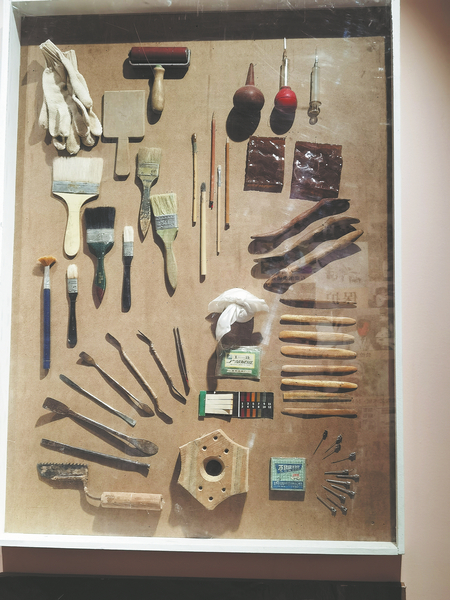
Restoration tools displayed at a gallery of the academy. WANG KAIHAO/CHINA DAILY
Mural doctors
Commonly seen "diseases" affecting the murals include cracking and flaking, as well as efflorescing that is caused by changes in temperature and humidity of the caves, and the deposition of salts.
To restore a mural requires an all-rounder. The restorer should know painting, master the skills of a mason and have some knowledge of chemistry and physics, to be able to recognize the problems, their corresponding causes and deliver a solution. They must also select proper materials and tools, and conduct experiments, before formally carrying out the restoration and evaluating the effect afterward.
For example, dealing with cracked murals with small flakes curling up usually involves removing the dust, injecting adhesives, backfilling the painted layer, then rolling and pressing to flatten the edges.
Ancient mural painters applied pigments made from different ingredients — cinnabar for red, for example — resulting in damage with different traits and to varying extents. The tricks of restoring these murals, therefore, often lie in a different level of adhesive used and timing for the operation, which requires years of learning and practice.
The restoration should respect the original work and aim to maintain the status quo of the murals rather than repainting them, Li says.
Even at the height of summer, when temperatures soar to nearly 40 C, the 58-year-old and his colleagues have to wear quilted coats and pants in the caves to keep warm. Arthritis is a hazard for some.
They also need to keep their hands raised for hours, exerting strength, but not shaking when their muscles tire, a challenge that can be very energy consuming, his colleague Li Lingzhi, 36, says.
However, for Li Bo, it's often not until he steps out of the caves after several immersive hours that he starts to feel the exhaustion.
Li Lingzhi says Li Bo shares all he knows without reserve.
He says, he's always impressed by the awe displayed by the older generations toward the cultural heritage, and the more comprehensive point of view they have of the tasks.
Li Bo admits that compared to "green hands", an experienced restorer spends less time forming up a solution, and meanwhile, they take a greater number of factors into consideration.
He has strong support behind him, including his father Li Yunhe, the academy's first full-time cultural heritage restorer, who has been dedicated to the cause since 1956.
Li Yunhe once removed a mural, completely intact, from a corridor in Cave 220 of Mogao Caves, to expose an older mural hidden underneath. He then placed the murals side by side so that scholars and tourists can see them both.
Li Bo grew up watching his father restore the murals and painted sculptures, taking in all he saw and heard. In 1983, he joined the academy, and was involved in the archaeological mapping of the caves before formally taking up the preservation and restoration of these cultural relics in 1990.
"I felt it was my duty to take care of my father while learning something at the same time, and he is very strict with me," Li Bo says.
Apart from restoring murals and painted sculptures at Gansu's cave temples, the father and son also attended preservation projects in Qinghai, Shanxi and Zhejiang provinces, as well as Tibet and Xinjiang Uygur autonomous regions, among others.
Thanks to rich experiences garnered by the Dunhuang Academy in the past decades, conservators there have supported preservation projects of earthen heritage sites and murals in 20 provincial-level administrative regions across the country. They have also contributed solutions to similar sites in other countries like Kyrgyzstan and Myanmar, according to Guo Qinglin, deputy director of the academy who is in charge of cultural heritage conservation.

Li Bo at the Mogao Caves. JIANG DONG/CHINA DAILY
Refreshed squad
In his teenage years, Li Bo often wondered why it seemed his predecessors never took days off despite adverse working and living conditions. He later realized they were driven by a sense of urgency.
Last year, his 91-year-old father fell and broke his left arm and damaged his lumbar vertebrae. The master kept up with his work remotely and couldn't wait to get back on site after three months of home confinement.
Li Bo's career has witnessed and benefited from the academy's evolution, from rescuing cultural heritage, to scientific and preventive conservation, making progress in both research and implementation of preservation measures.
Interdisciplinary achievements, such as updated research findings in materials science, and new digitalization technology, have greatly facilitated their work. And the academy has formed a well-established cooperative mechanism that guarantees suitable staff with different specialties in each preservation project, as well as regular summary and exchange sessions.
According to Guo, more than 150 conservators and restorers from the academy now work on the front line, minding the caves.
"Many of them may not be well-educated, but they excel after decades of practice in the field, and their experience is priceless," Guo says. "As master artisans of our nation, they deserve people's utmost admiration."
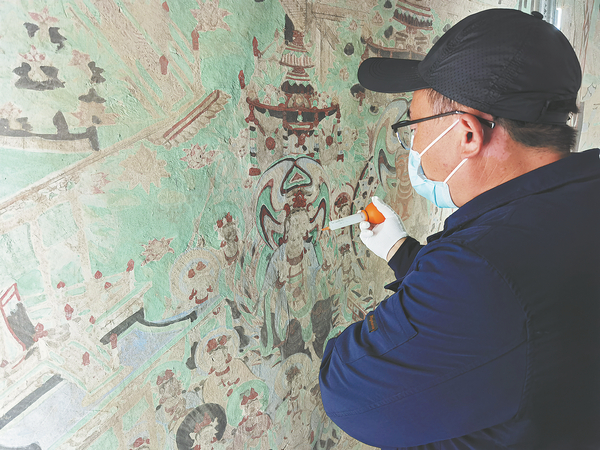
Earlier this month, a restorer from the Dunhuang Academy works on murals of Cave 55 of Mogao, dating back to the 10th century. WANG KAIHAO/CHINA DAILY
At the academy, the conservation team with members of higher education backgrounds in the natural sciences, including chemistry, geology, microbiology and so on, is devoted to digitalization and detailed analysis in labs to draft tailored prescriptions for each earthen "patient".
"Cave conservation is about continuously solving problems," Guo says. "But the more work we do, the more problems we'll encounter.
"In the past, maybe we would rely on experience and refer to solutions that had previously been effective," he adds. "But now we realize there's no panacea. We have to make a plan for each specific scenario after a rigid evaluation."
The Mogao Caves have existed for more than 1,000 years. No matter how much effort their guards and restorers have spent, whether it is in conservation or trying to rein in the neighboring sand dunes, everyone understands a simple fact: They can only slow down the aging of caves, but they cannot stop it.
"For example, climate change is a major factor influencing the murals in the caves," Su Bomin, director of the Dunhuang Academy, says. "It needs a long-term research to better preserve the caves, over a much wider time span that goes beyond our lifetimes."
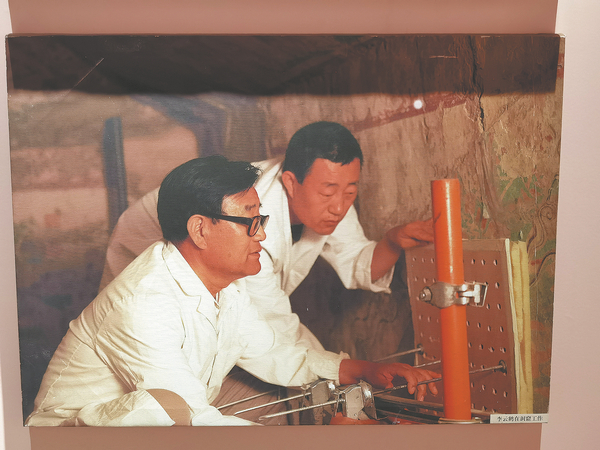
In a photo on display at the academy, taken in the early 2000s, Li Bo (right) works with his father Li Yunhe, the academy's first full-time cultural heritage restorer, who has been dedicated to the cause since 1956. WANG KAIHAO/CHINA DAILY
When the restorers find some parts of murals missing or fading away, they will never repaint to create a "perfect" appearance in restoration.
"Cultural relics are witnesses of history," Su explains. "When you pursue the so-called intact look for artistic reasons, you will lose their key meaning. More importantly, our work can promote the great Dunhuang spirit of inclusiveness to the world and inspire modern people."
Today, Li Bo still guides new generations of restorers who shuttle among the caves. At least, they want to keep the current look of the murals as long as possible.
"I'm not willing to retire," Li Bo says. "If I get too old to continue one day, I still want to teach more students. ... New generations will surpass us, not only in the matter of traditional techniques, but also, when new knowledge and technologies emerge, they will present a wider view and more comprehensive ability.
"The process is like a sponge," he says. "By constantly absorbing different knowledge, there will be plenty of it available when it is required."
Wang Jiahui in Dunhuang contributed to this story.